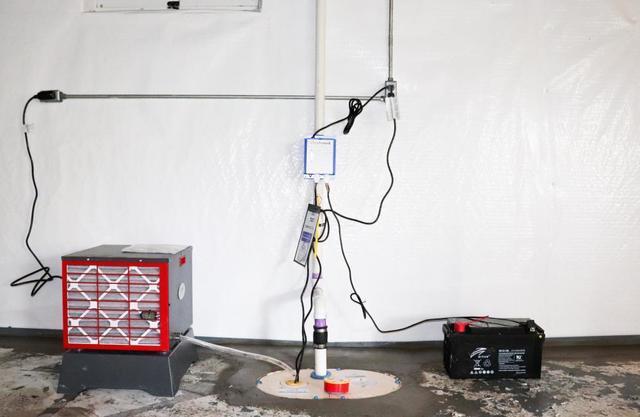Proudly serving Minnesota and Wisconsin - including Duluth, Minneapolis, Eau Claire and nearby areas
Interior vs. Exterior Basement Waterproofing: What is best for your home?

So your basement gets wet whenever it rains, and you don't know the best way to fix it? What is best for your home, interior basement waterproofing or exterior basement waterproofing? Read this paper to learn more about basement waterproofing, and how DBS can help give you the peace of mind that your basement is staying dry.
What is exterior waterproofing?
Exterior waterproofing is installed by excavating the soil from the exterior of the foundation walls. The exterior drain tile is then installed at the base of the exterior footing, causing more disruption to the foundation of the home. The weight of the soil often causes low areas on the drain tile or can even crush the drain tile during installation if not installed properly. Just 6 ft x 1 ft x1 ft of sand weighs 600 pounds.

Concerns with exterior waterproofing:
- Full exterior waterproofing requires excavation of all the walls of the home. If the home has an attached garage or porch, it will prevent being able to have a full exterior waterproofing system. In these scenarios, there are no guarantees that the basement wouldn’t leak.
- Another common issue with exterior waterproofing is that the exterior drain tile is outside the home under the soil, and it will clog up much faster and easier than the interior drainage system.
- Exterior waterproofing will also make a mess in the yard and any concrete sidewalks, steps, gardening, plants, and grass will need to be redone after the work is done.
- Even when the backfilled soil is ramped up in layers it will still settle, causing additional grading work in the future. This is often seen in new construction when the soil settles and causes a negative grade around the home, which directs water back toward the home.
What is interior waterproofing?
Interior waterproofing is one of the most effective techniques for waterproofing an existing basement. Our Waterguard® drain system is installed around the perimeter of the basement where the foundation walls meet the floor. The drain system collects any intruding water and directs it to the sump pump to be pumped out and away from the house.

Often our interior drainage system is paired with other waterproofing solutions to ensure an effective waterproofing system. Some of our most common pairings are the CleanSpace® Wall Vapor Barrier and TripleSafe™ Sump Pump System.
The CleanSpace® is installed along the walls of the basement to hold back water vapor passing through the foundation walls, directing it to the Waterguard® drain system and into the sump pump. The vapor barrier also known as CleanSpace® has anti-microbial protection to prevent any mold or mildew growth, keeping your basement clean and healthy.

The TripleSafe™ Sump Pump System provides three levels of protection: cast-iron Zoeller® ⅓ horsepower sump pump set at the lowest level. A second, more powerful Zoeller® ½ hp pump set a bit higher in the liner, will take over if the water surpasses the primary pump. In case of a power outage, our UltraSump® battery backup sump pump, set at the highest level, will pump 11,500 gallons or more on a fully charged battery.


Another common system we use to help keep basements dry is our SaniDry™ Dehumidifier. Often in basements with concrete or stone walls and concrete floors, moisture can still absorb into the air of the basement even with an effective waterproofing system. With our SaniDry™ dehumidifiers, the air circulated throughout the basement, and any collected water is drained into the sump pump.

What are the benefits of interior waterproofing?
- The interior Waterguard® drain tile system comes with a lifetime transferable warranty.
- The installation of Waterguard® will not affect the structural integrity of the home.
- Our interior waterproofing solutions can be installed all year round.
- A dry basement!

We do the work all year round!
Interior waterproofing allows us to do the work all year round, keeping your home protected from further water intrusion when the snow melts in the spring! If water is in your basement after a heavy rain or you notice water leaking in after snow melts in the spring, DBS can help! Our crews at DBS work all year round to keep your home healthy, safe, and comfortable with our interior waterproofing solutions! Call us today at 218-525-0720 or fill out a Free Estimate Form to get started!
our service area
We serve the following areas
- Abbotsford
- Augusta
- Boyd
- Brantwood
- Chili
- Colby
- Curtiss
- Dorchester
- Fairchild
- Fall Creek
- Granton
- Greenwood
- Humbird
- Loyal
- Lublin
- Medford
- Neillsville
- Ogema
- Osseo
- Owen
- Prentice
- Rib Lake
- Stanley
- Stetsonville
- Strum
- Thorp
- Westboro
- Willard
- Withee
- Brownsville
- Caledonia
- Canton
- Dakota
- Eitzen
- Fountain
- Harmony
- Hokah
- Houston
- La Crescent
- Lanesboro
- Lewiston
- Mabel
- Minnesota City
- Peterson
- Preston
- Rollingstone
- Rushford
- Spring Grove
- Utica
- Winona

